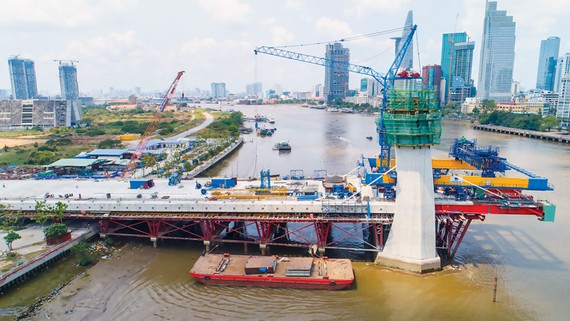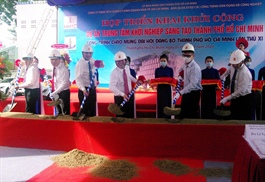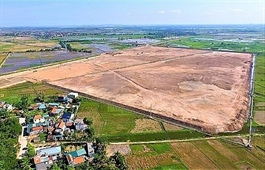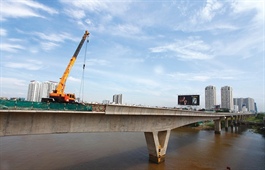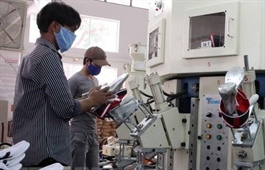Inconsistencies in disbursement of public investment
Inconsistencies in disbursement of public investment
Disbursement of public investment capital requires improved legal framework in the management and implementation of all public investment projects. Recent changes in policies and laws have brought about inconsistencies in the disbursement of public investment capital, causing further confusion in many localities.
Bridge Thu Thiem 2 connecting from District 1 to District 2 has halted construction due to site clearance problems.
|
Localities seek return of capital
According to the Ministry of Planning and Investment, the total investment capital realized from the state budget in the first seven months of 2020 reached around VND 203,000 bn, an increase of 27.2% compared to the same period in 2019. This was the highest investment amount in the period 2016 to 2020, of which, capital from central budget was 16%, and 84% was from the local budget.
With reference to the central budget, investment capital disbursement rate in seven months reached about 60%, but was only 38.4% of the plan. With reference to the local budget, total investment capital that needs to be disbursed as planned this year is about VND 351,000 bn, but only about VND 170,000 bn has been disbursed, which is 42.6% of the plan. This has put great pressure on many localities in the last months of the year, and up until now nine provinces and cities have requested the public investment for projects with slow disbursement to be reimbursed or returned.
Ho Chi Minh City has always remained in the top localities in the country for many years for effectively disbursing public investment. According to the People's Committee of Ho Chi Minh City, in 2020 the City has allocated capital for public investment worth VND 42,139 bn. In this, the State Budget Capital is about VND 33,940 bn and Central Budget Capital is VND 8,198 bn. As of 31 August, Ho Chi Minh City had disbursed VND 21,472 bn out of VND 42,139 bn assigned. In this the City Budget Capital was VND 17,314 bn and the Central Budget Capital was VND 4,158 bn. According to the People's Committee of Ho Chi Minh City, it will affect the economic recovery of Ho Chi Minh City, but will also create great pressure for the City in the last months of the year. Therefore, Ho Chi Minh City only aims to complete 95% of the plan to disburse financial funds this year.
Bottlenecks in site clearance
The 2019 Law on Public Investment became effective from 1 January 2020. It has very detailed provisions in planning, as well as strict rules in Article 16 to prevent corruption and loss of public investment capital. However, the responsibility assigned to related agencies and units on how to use the investment capital according to the plan and the sanctions related to capital are still very vague. Therefore, the 2019 Law on Public Investment requires the Government to give specific guidelines for relevant legal documents, including Investment Law, Construction Law, Land Law, and Bidding Law, so as to ensure consistency and clarity.
For instance, the biggest problem localities encounter when implementing disbursement is site clearance. According to Mr. Mai Xuan Liem, Vice Chairman of the People's Committee of Thanh Hoa Province, the task of site clearance, compensation, relocation and resettlement before implementing any public investment project is the most difficult stage. By the end of August 2020, Thanh Hoa province had completed disbursing 66.4% of total financial resources assigned for 2020. However, to complete the plan, the progress of capital disbursement must be accelerated, which depends a lot on site clearance to implement the projects.
| Localities face many difficulties in disbursing public investment capital, due to changes in mechanisms, policies and laws, but lack of synchronization, making the procedures so complex. |
For example, the provisions of the Land Law now create the difference in land prices between the compensation price and the market price. The regulations on land prices to compensate people upon acquisition under Article 112 and Article 114 of the 2013 Land Law guided in Decree 44/2014/ND-CP have been implemented according to the principle of ensuring close proximity. However, there are still large gaps that need to be overcome.
According to Prof. Dang Hung Vo, former Deputy Minister of Natural Resources and Environment, in Article 112 of the 2013 Land Law, the land valuation must ensure the following principles: (i) the land use purpose at the time of valuation. (ii) clear land use terms. (iii) prevailing market price of land with income from land use. (iv) profitability and income from similar land use to have the same price.
Prof. Dang Hung Vo also emphasized that the Land Law did not fully anticipate the possibility that before acquiring, the purpose of using the land could be only for agriculture, not urban residential purposes, or the pre-acquisition land may be located in the middle of the field, but after the project is implemented by the investor, the land will be changed to increase the compensation value. Prof. Vo feels that this is also the reason that many public investment projects, despite disbursement, cannot acquire the land from the people, which then leads to loss of compensation, delays in site clearance and investment capital flow.


